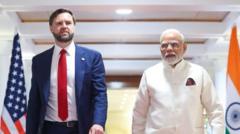In a meeting in Delhi, Modi and Vance expressed mutual commitment to fostering trade, technology, and defence collaborations. Vance, visiting India with his family for four days, found the discussions constructive, signaling a potential reduction of tensions in trade relations. Modi emphasized India's readiness for beneficial cooperation on several fronts after a dinner that acknowledged their shared interests.
The backdrop of these talks involves a proposed increase in tariffs that could see India facing a significant 27% tariff on goods once a temporary pause period by the US comes to an end on July 9. This has intensified the urgency for both nations to finalize negotiations to prevent adverse trade impacts. Modi and US President Donald Trump have cultivated a friendly relationship; nevertheless, Trump has frequently criticized India's high tariffs, labeling the country as a "tariff king" and pointing out an imbalance in their trade relationship.
While India has already made strides in reducing tariffs on numerous products and is considering broader cuts, significant obstacles remain, particularly in the realm of agriculture. Negotiations over access to the US agricultural market continue to complicate the dialogue, with India prioritizing its domestic farming interests.
Aside from trade agreements, the discussions encompassed defence collaborations and energy exchanges, further integrating the two nations strategically. Modi anticipates Trump's participation in the Quad summit later this year, which will further solidify their partnership.
Vance's visit has a personal touch as well, as he seeks to connect his children to their Indian heritage, with family activities planned across historical sites following the meeting. The visit underscores the ongoing blend of diplomatic and personal ties, as both nations work toward a stronger future collaboration.
As India prepares to navigate the implications of upcoming tariffs, the outcome of these trade discussions remains a focal point of concern and opportunity for both economic partners.
The backdrop of these talks involves a proposed increase in tariffs that could see India facing a significant 27% tariff on goods once a temporary pause period by the US comes to an end on July 9. This has intensified the urgency for both nations to finalize negotiations to prevent adverse trade impacts. Modi and US President Donald Trump have cultivated a friendly relationship; nevertheless, Trump has frequently criticized India's high tariffs, labeling the country as a "tariff king" and pointing out an imbalance in their trade relationship.
While India has already made strides in reducing tariffs on numerous products and is considering broader cuts, significant obstacles remain, particularly in the realm of agriculture. Negotiations over access to the US agricultural market continue to complicate the dialogue, with India prioritizing its domestic farming interests.
Aside from trade agreements, the discussions encompassed defence collaborations and energy exchanges, further integrating the two nations strategically. Modi anticipates Trump's participation in the Quad summit later this year, which will further solidify their partnership.
Vance's visit has a personal touch as well, as he seeks to connect his children to their Indian heritage, with family activities planned across historical sites following the meeting. The visit underscores the ongoing blend of diplomatic and personal ties, as both nations work toward a stronger future collaboration.
As India prepares to navigate the implications of upcoming tariffs, the outcome of these trade discussions remains a focal point of concern and opportunity for both economic partners.




















